Kurlash
In 1923, a group of investors founded the Stickel Company at 380 Cottage Street, Rochester, New York State to market the Kurlash Natural Eyelash Curler, a patented device invented by Charles W. Stickel [1889-1943].
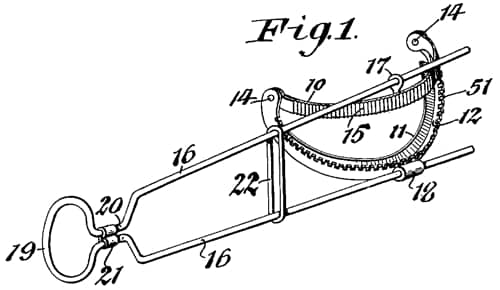
Above: Patent drawing of an eyelash crimper (U.S. Patent No: 1542014, 1925) invented by Charles W. Stickel. The device was sometimes referred to as the ‘bear trap’.
The Kurlash Natural Eyelash Curler was sold in two forms: a gold ‘F’ model (US$5.00) packaged in a blue Morocco leather case; and an ‘S’ model (US$2.00) with a silver-like finish sold in a plush-lined cardboard box.
You can have prettier eyes by a natural method, without use of pastes, creams, artificial lashes or even heat. Curl your lashes upward and they appear longer; your eyes will look brighter, larger, more fascinating.
(Stickel advertisement, 1923)
The product was only briefly on the market. By 1924, it had been replaced by a more sophisticated model similar to a device patented in 1929 by Charles W. Stickel and William E. McDonell [1882-1941] – another Rochester resident known for numerous ocular inventions. The new model was also cheaper as, by the end of 1924, the price of a Kurlash had dropped to US$1.00.
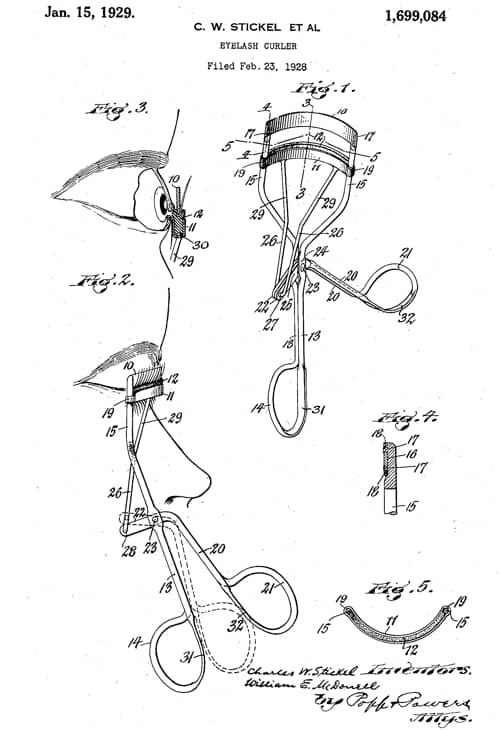
Above: 1929 Drawing of an eyelash curler (U.S. Patent No: 1699084, 1929) invented by Charles W. Stickel and William E. McDonell.
The Stickel Company marketed Kurlash nationwide, hired salesmen to get the product stocked in stores and set up a mail-order business for women who could not find a Kurlash locally. The sales manager mentioned in the advertisement is William R. Tuttle [1887-1953] an investor who would go on to become the company president.
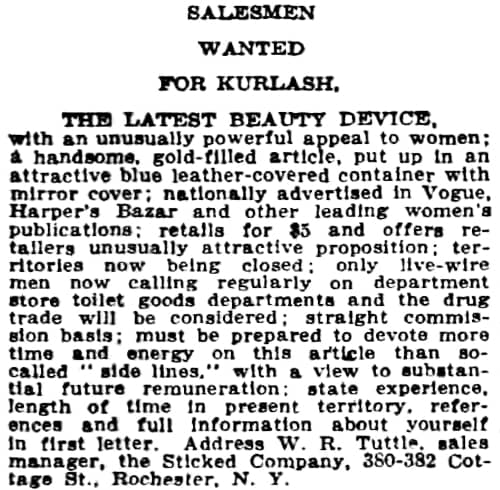
Above: 1923 Advertisement for Kurlash salesmen. The company name has been erroneous printed as ‘Sticked’.
Charles Stickel can be said to have invented the eyelash curler/crimper. Two other eyelash curlers had been granted patents before Stickel’s ‘bear trap’ patent came through – US1527964 and US1532238 – but Stickel’s patent was submitted to the patent office before them and was the first to be commercialised. However, given the strong similarity between the second Kurlash introduced in 1924 and modern eyelash curlers I credit the invention of the eyelash curler to McDonell as well as Stickel.
Name change
In 1928, the Stickel Company, Inc. filed a certificate to change its name to the Kurlash Company, Inc. and took up new offices at 77 South Avenue, Rochester. The company was not adversely affected by the Great Depression which began with the stock market crash of 1929. Its American sales actually rose between 1929 and 1931 helped by the adoption of its eyelash curler by Hollywood movie stars, its use of radio advertising, and the introduction of new products. Company profits were also boosted by exports of Kurlash eyelash curlers around the world.
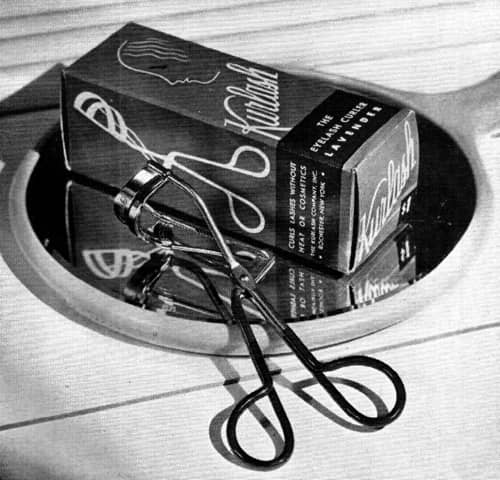
Above: 1934 Kurlash eyelash curler.
This is not to say that the company sailed through the 1930s unscathed. In 1932, a dispute arose between two groups of investors, with Tuttle, Stickel and others on one side and Wilson B. Prophet, a major investor, on the other. The matter went all the way to the Supreme Court which decided in favour of the Tuttle and Stickel group in 1934.
New products
In 1930, the Kurlash Company extended its product range with six new eye products: Tweezette, an automatic eyebrow tweezer; Lashtint, a liquid mascara; Lashpac, a block mascara and brush; Kurlene an eyelash grower; and Shadette, a compact eyeshadow.
Tweezette: “[T]he automatic, painless tweezers that make it so simple to keep your brows well groomed.”
Lashtint: “This perfumed liquid tint makes thin or pale lashes appear luxuriant, dark brilliant. Keeps the lashes soft, pliable, silky and natural-looking. Does not flake, crumble, crack or break. Dries in a jiffy. Waterproof, but easily removed with cold cream”. Shades: Black, Brown and Blue with Green added in 1936.
Lashpac: “[A] unique stick of mascara, like a lipstick, to darken lashes and mark brows. It has a clever little brush for grooming too!” Shades: Black, Brown, and Blue with Green added in 1936.
Kurlene: “[M]ade of rich natural oils, carefully and scientifically compounded, promotes the growth and luxuriance of the lashes. A small amount applied each night and rubbed in well, should quickly overcome unfavorable conditions leaving weak and unattractive lashes capable of normal development”. In jars and tubes.
Shadette: “Gives mystery, depth to the eyes.” Shades: Brown, Blue, Green and Violet.
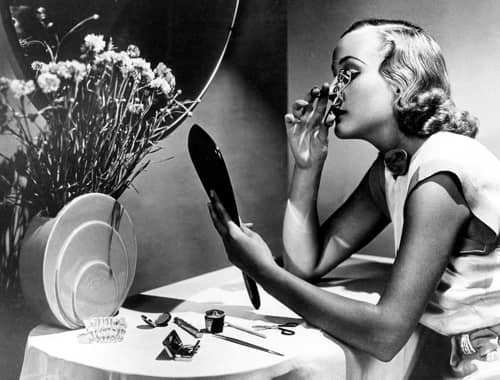
Above: 1937 Model using Kurlash products.
Kurlash combined all of these products into its recommended eye make-up routine:
Step 1—With Tweezette remove straggling eyebrow growth over bridge of nose betwen eyebrows, and make eyebrow clear cut.
Step 2—Use Kurlene systematically, to promote the growth of dark luxuriant lashes. Also to produce glossiness as desired.
Step 3—Apply Shadette lightly for day time (with deeper shading in evening) to give size depth and luster to your eyes.
Step 4—With Kurlash curl the upper eyelashes up, making eyes appear larger and lashes seem very long. To accentuate the curl use Lashpac on just the tips of lashes while held in Kurlash. For those who wear glasses Kurlash is a boon, for the eyes look larger.
Step 5—Use Lashtint, (only on upper lashes) to give the shade of color desired. Use Kurlene on lower lashes to bring out natural tone and freshness.
Step 6—Use Lashpac for the same purpose as Lashtint at any time, even to touch up color during the day. also darken brows slightly with Lashpac.(Kurlash, 1936)
A compact form of Lashtint mascara existed alongside the liquid form and, by 1934, this was being sold in a patented container that included a sponge to hold water for moistening the mascara brush.
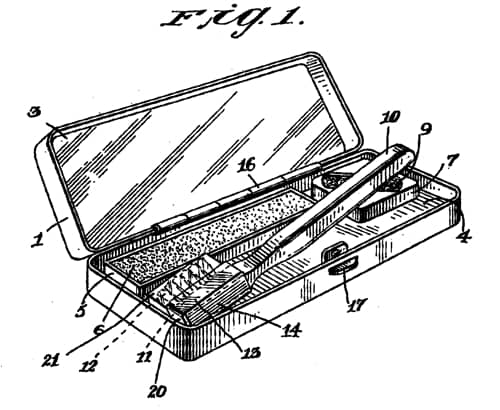
Above: Patent drawing of a cosmetic compact (U.S. Patent No: 1902681, 1933) invented by Charles W. Stickel and William R. Tuttle.
Lashtint Compact: “A patented mascara case with a little sponge, ensuring just the right consistency to darken the lashes naturally without stiffening or caking”. Shades: Black, Brown, and Blue with Green added in 1936.
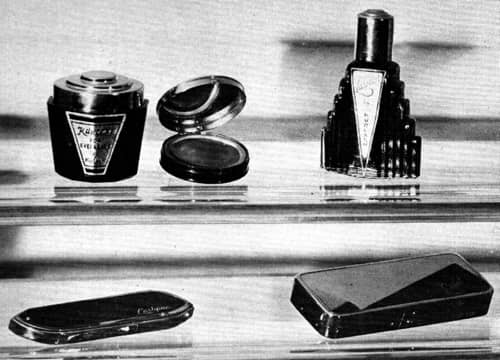
Above: 1934 Kurlash products. Top row: Kurlene, Shadette and Lashtint. Bottom Row: Lashpac and Lashtint Compact.
Kurlash also added a new patented tweezer in 1934. Its scissor-like handles had a bend in them to make it easier to see the eyebrows when it was being used. A professional version was introduced in 1940 sold through department stores. Similar tweezers are still on the market today.
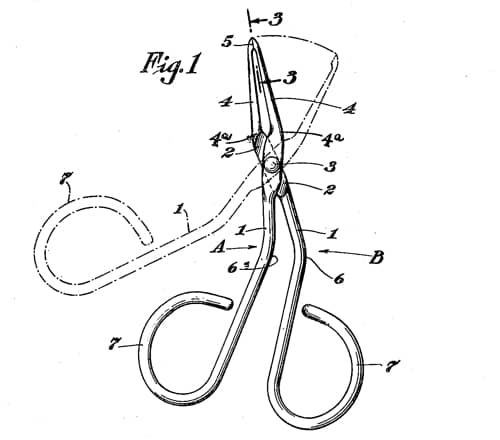
Above: 1937 Drawing of a pair of tweezers (U.S. Patent No: 12089177, 1937) invented by William J. Beldue.
Twissors: “[T]he new tweezers with scissor-handles, curved to permit full vision. They’re marvelously efficient”.
The patent covering the Twissors was issued to William Beldue, another Rochester resident. His connection with Kurlash came through Charles Stickel. The two men had previously worked together on a patented fish lure (US1842127, 1932). After Stickel’s death in 1941, Beldue seems to have taken over the role of product development at Kurlash and his name appears on a number of Kurlash patents through to his death in 1955.
In 1936, Kurlash added Gold and Mahogany tones to its Shadette range bringing the total number of shades to twelve – Light Blue, Royal Blue, Gray Blue, Aqua Blue, Spring Green, Olive Green, Violet, Brown, Mahogany, Black, Silver and Gold and followed this with Iridescent Shadettes (1938) which sparkled in blue, violet, green and bronze shades. The company also manufactured a gold-plated beauty brush to apply the eyeshadow to the eyelids.
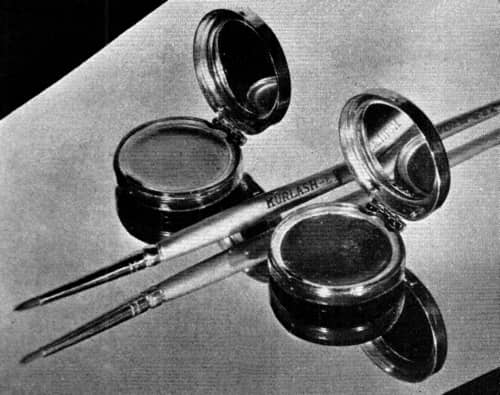
Above: 1936 Kurlash Shadette and brush. The bottom of the Shadette metal cases are black, the tops silver. The gold painted brush is fitted with fine camel hair.
The last product added by Kurlash during the 1930s was an Eyebrow Pencil. In production by 1937 at the latest, it completed the company’s line of eye make-up.
Also see: Kurlash make-up color guide (1936)
I have no records of any new products at Kurlash between 1937 and the entry of the United States into the Second World War in December, 1941. The Kurlash eyelash curler had been improved earlier in 1941 – with larger thumb and finger loops, better leverage, a wider opening and a new cushion guard – but production ceased when the factory was repurposed for the war effort in 1943.

Above: 1943 Kurlene advertisement alerting customers to the Kurlash shortage. All mentions of Kurlash being an eyelash grower have also been dropped due to the passing of the Food, Drug and Cosmetic Act (FD&CA) in 1938.
Post-war
Production of the Kurlash eyelash curler started again after 1945 but the outlook for the company was unfavourable. The Kurlash patents had expired and before the end of the decade new eyelash curlers looking very similar to the Kurlash began appearing on the market.
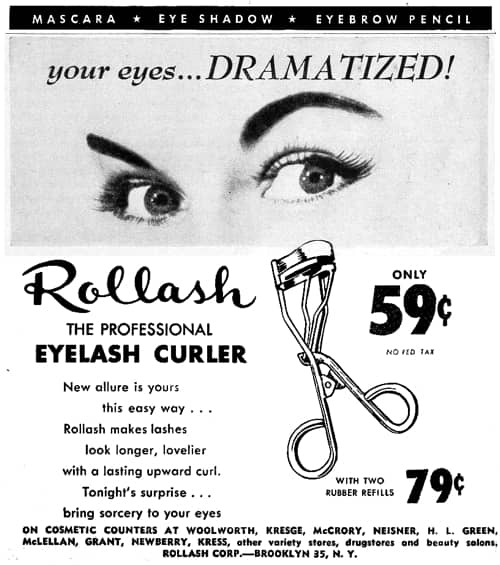
Above: 1953 Rollash, a copy of the Kurlash design.
I have no records of any new product development at Kurlash between 1945 and William Tuttle’s death in 1953. By then, Tuttle owned 975 of the 977 company shares, the remaining two being held by Mildred K. Tuttle, his wife and Mrs. Helen Lamb, his sister.
Mildred Tuttle decided to sell the company after her husband’s death and, in 1957, Kurlash was bought by the Glemby Company (New York), who acquired a 55% share, and the House of Westmore (New York), who bought the remaining 45%. The owners of Glemby were major investors in the House of Hollywood.
See also: House of Westmore
In 1957, Helena Rubinstein introduced her Mascara-matic which marked the end of the long reign of cake mascaras. In 1959, the new owners of Kurlash responded to the Mascara-matic with a new Lashtint Mascara. This automatic mascara and lash comb in one used the same design as the Aziza Azizamatique, manufactured by the Scoville Manufacturing Company of Waterbury, Connecticut. In the same year, Kurlash also added Evening Eyes, a stick eyeshadow in five iridescent shades.
See also: Automatic Mascara
In the 1960s, the House of Westmore (New York) bought Glemby’s share of Kurlash but then, in 1964, sold it along with Diamon Deb, Inc. – a manicure implements company they also owned – to Harold M. Mitchell, Inc.
The Kurlash company continued to be linked with Diamon Deb through subsequent owners which included: Robert Roth and Mario Maffie, the owners of Verla International Ltd., a packager of nail enamels; Cook Bates, Inc., a nail-care products maker; and Pacer Technology, a manufacturer of adhesives including Super Glue.
With each new owner the Kurlash brand gradually faded from existence. However, its influence lives on today in the numerous Kurlash-like eyelash curlers and tweezers still on the market.
Timeline
| 1923 | Stickel Company founded at 380 Cottage Street, Rochester, New York. New Products: Kurlash Natural Eyelash Curler. |
| 1924 | Kurlash eyelash curler redesigned. |
| 1925 | Stickel moves to 130 North Clinton, Building Rochester. |
| 1926 | Radio advertising commences. |
| 1928 | Stickel Company renamed Kurlash Company. |
| 1930 | New Products: Tweezette, Kurlene, Shadette, Lashtint and Lashpac. |
| 1931 | New Products: Purse-sized folding Kurlash. |
| n.d. | Kurlash Company of Canada established at 1475 Queen Street West, Toronto. |
| n.d. | Exports commence. |
| 1934 | Kurlash eyelash curler improved. New Products: Twissors. |
| 1938 | New Products: Iridescent Shadettes. |
| 1940 | New Products: Professional Twissors. |
| 1941 | Kurlash eyelash curler redesigned. |
| 1957 | Kurlash sold to Glemby and Westmores. |
| 1959 | New Products: Evening Eyes eyeshadow; and Automatic Lashtint. |
| 1961 | Westmores acquires remainder of Kurlash and combines it with Diamon Deb Ltd. |
| 1964 | Kurlash-Diamon Deb sold to Harold M. Mitchell, Inc. |
| 1980 | Kurlash-Diamon Deb sold to Robert Roth and Mario Maffie. |
| 1985 | Kurlash-Diamon Deb moves to Newburgh, Orange County, New York State. |
| n.d. | Kurlash-Diamon Deb sold to Cook Bates, Inc. |
| 1998 | Cook Bates, Inc. sold to Pacer Technology. |
| 2001 | Cook Bates division of Pacer Technology sold to the W.E. Bassett Company |
Updated: 24th June 2018
Sources
The American perfumer & essential oil review. (1906-1955). New York: Robbins Perfumer Co. [etc.].
Kurlash endures a million eyes later. (1984, February 13). The Herald Statesman, p. 9.
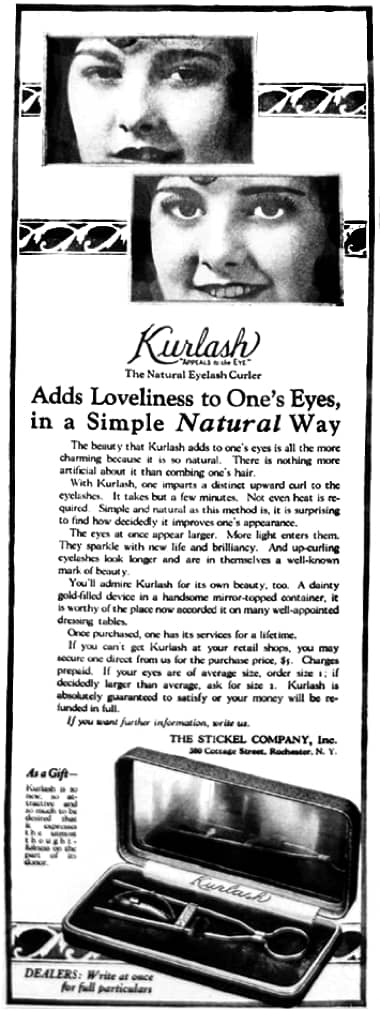
c.1923 Stickel Company Kurlash Natural Eyelash Curler, the ‘bear trap’.
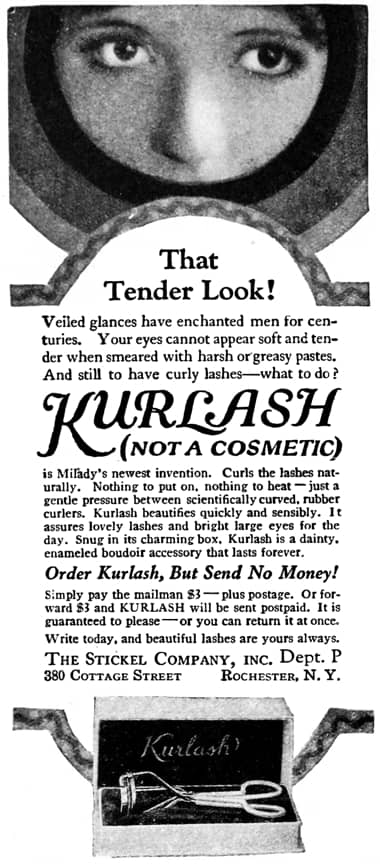
1924 Stickel Company Kurlash.

1925 Stickel Company Kurlash.

1926 Perc Westmore [1904-1970] curling the eyelashes of Anna Q. Nilsson [1888-1974]. Kurlash was advertised as being able to curl lashes without heat but Perc Westmore has connected one to batteries to warm the device electrically.
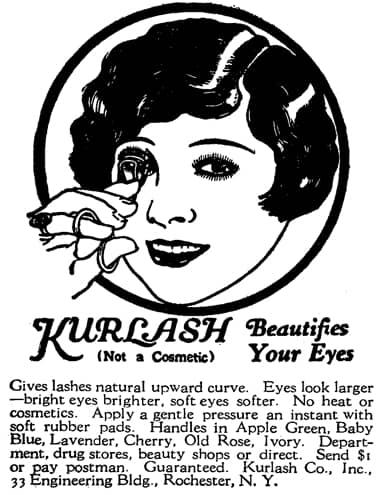
1928 Kurlash Company Kurlash.
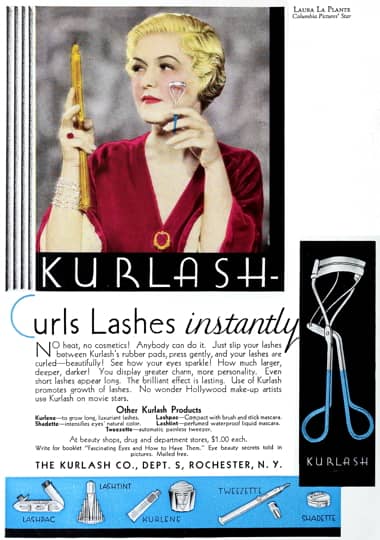
1931 Kurlash Company Kurlash, Lashpac, Lashtint, Kurlene (jar and tube), Tweezette and Shadette. The handles on the Kurlash are coloured Baby Blue. Other available handle colours were Apple Green, Lavender, Cherry, Old Rose and Ivory.
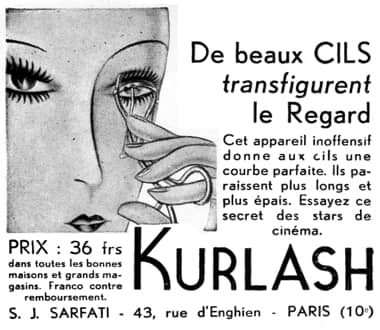
1934 Kurlash (French).

1936 Kurlash, Lashtint Compact, Kurlene and Twissors. The Jane Heath mentioned in the advertising is most likely a fictitious creation of Kurlash’s advertising agency.
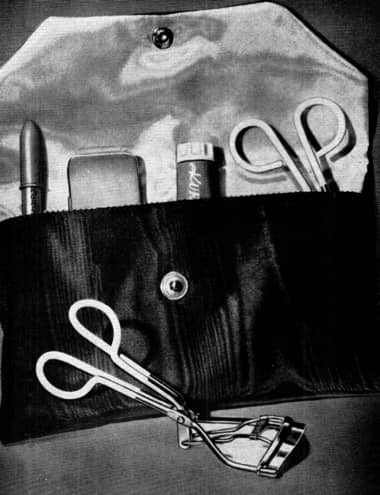
1939 Kurlash Grooming Kit (Purset). The kit came with a Kurlash eyelash curler, Kurlene lash cream, Twissors, mascara compact and an eyebrow pencil in pale green and white packages contained in a dubonnet or royal blue silk moire bag.

1942 Kurlash.
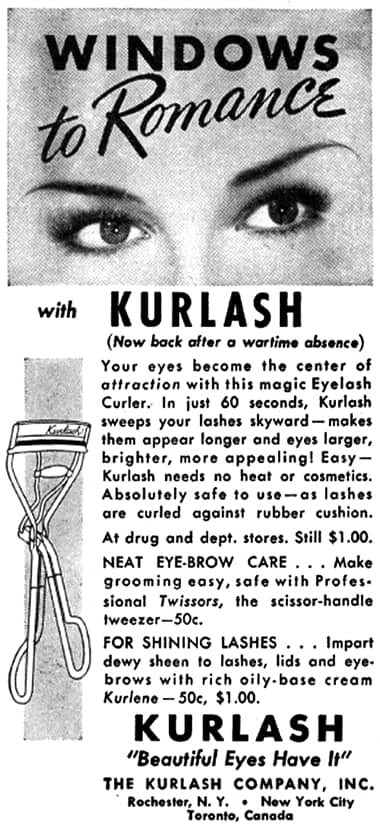
1946 Kurlash back after wartime absence.
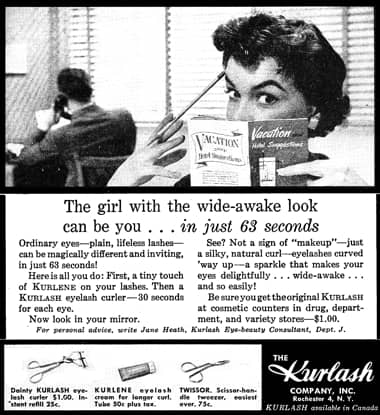
1954 Kurlash, Kurlene and Twissors.
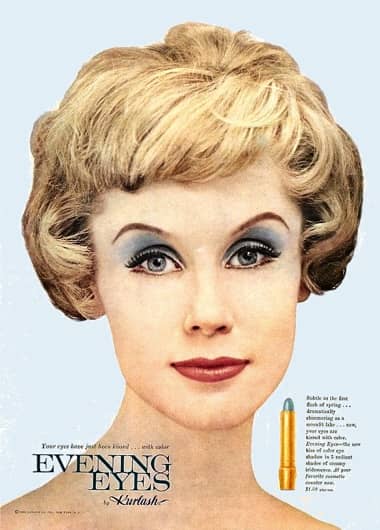
1959 Kurlash Evening Eyes stick eyeshadow.

1960 Kurlash Eyelash Curler, Evening Eyes Eyeshadow, Lashtint Mascara, Kurlene Eyelash Cream and Twissors.
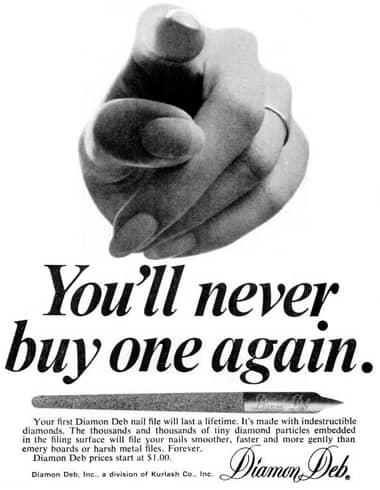
1966 Diamon Deb, a division of Kurlash.
